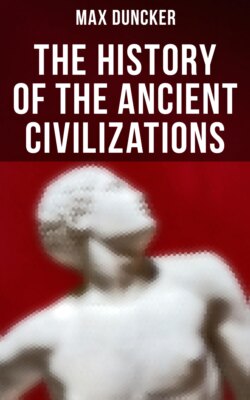Читать книгу The History of the Ancient Civilizations - Duncker Max - Страница 7
На сайте Литреса книга снята с продажи.
FOOTNOTES:
Оглавление[1] Bunsen, "Ægypten," 5, 1, 75 ff.; Ebers, "Ægypten and die Bücher Moses," p. 43; Renan ("Histoire générale et système comparé des langues Sémitiques") will not admit this close connection.
[2] Brugsch ("Histoire d'Egypte," pp. 5, 6) explains the name Egypt by ha-ka-ptah, i.e. "the precinct of Ptah." As Ptah was more especially the god of Memphis, this name would have come from Memphis. The attempt has been repeatedly made to derive the civilisation of Egypt from Ethiopia and Meroe. But the problem of the origin of a given civilisation is not solved by removing it from the locality where it exists in full bloom to another, and as a rule more unknown, district. In the case before us this assumption is met by the peculiar difficulty, that the culture of Egypt is influenced essentially by the nature of the land, and therefore can hardly have had an external origin. It cannot be removed from a highly favoured locality into a district extremely hot, and fruitful only in detached oases, without making the explanation of its origin much more difficult. Moreover, the lower valley of the Nile has always ruled over the upper: even in mediæval and modern times. The inscriptions of Sargon, king of Assyria (722–705 B.C.), mention the king of Meroe (Miluhhi); those of Sennacherib (705–681 B.C.) tell us, "The kings of Egypt have summoned the archers, the chariots, the horses of the king of Miluhhi." The inscriptions of Esarhaddon (681–668 B.C.) speak of the "King of Egypt and Miluhhi," whom they also name "King of Egypt and Cush;" and the successor of Esarhaddon directed his first campaign against "Tarku" (Thirhaka) "of Egypt and Miluhhi." The word Meroe, therefore, as the name of a kingdom lying above Egypt on the Nile, must have been in use in Syria, even in the eighth century B.C. Hence the Greeks denote by this name an island, and also a city of the Upper Nile. According to Herodotus (2, 29) the great city Meroe, "which ought to be the chief city of the rest of the Ethiopians" (i.e. of those of whom the Egyptians were not the immediate neighbours), was forty days' journey and twelve days' sail (i.e. over 15,000 stadia) above Syene. Later authorities, Eratosthenes, Artemidorus, Strabo, Pliny, Ptolemy reduce the distance by nearly one-half; they regard the distance between Meroe and Syene as nearly equal to the distance from Syene to Alexandria, and fix the whole distance from Alexandria to Meroe at 10,000 to 12,000 stadia. As the town and island of Meroe must be south of the junction of the Astaboras (Atbara), (Strabo, p. 786), we must look for the island between the Atbara and the Blue Nile, and for the city in the ruins at the modern Begerauieh. Yet the chief town of the kingdom of Meroe, when it takes an active part in history, is not Begerauieh. King Thirhaka's residence lay near the modern Meraui under Mount Barkal. The name in inscriptions is Neb, and, consequently, in Greek and Latin Napata. Even under the Sesurtesen and Amenemha, Egypt ruled over Nubia as far as Semne and Kumna, under Amenophis III. as far as Soleb, and under Ramses II. as far as Mt. Barkal. The oldest ruins at this spot belong to a temple dedicated by this king to Ammon (Lepsius, "Reisebriefe," s. 238); next come the ruins of the buildings of Thirhaka, which differ as little from Egyptian buildings as those which he and his two Ethiopian predecessors erected in Egypt. Moreover, the later ruins found at Napata, especially some twenty small pyramids, are feeble imitations of Egyptian art. The same character of imitation is stamped upon the monuments of Begerauieh, though here it is mingled with foreign elements. This place, further removed from Egypt, and therefore more secure, was beyond doubt the residence of the kings of Meroe, at least from the time of Cambyses, and it was named after the country. Herodotus points out that Zeus and Dionysus, i.e. Osiris, were worshipped here, and that the oracle of Zeus, i.e. of Ammon, extended its authority over the Ethiopians: the further accounts which Diodorus preserves of this priesthood give a poor idea of their cultivation (3, 3 ff. Strabo, pp. 827, 828). At the time of the second Ptolemy, this priesthood was destroyed by the King, Ergamenes, whose name (Arkamen) Lepsius has discovered on ruins at Mt. Barkal, as well as Begerauieh, and an independent monarchy was established. Hence we must entirely give up the idea of deriving the supposed supremacy of the priesthood in Egypt, a supremacy which never existed here, from the priesthood formed at Begerauieh after the time of Thirhaka and Psammetichus (in the days of Psammetichus, Herodotus tells us that a king of the Ethiopians received strangers without an oracle, and gave them land, 2, 30); that is, in the sixth century B.C., which continued to exist till 250 B.C. Still less reason is there to suppose that the so-called Indian supremacy of the priesthood came through Meroe into Egypt. Rather we may feel ourselves justified in assuming that the elements of civilisation which took root on the middle Nile passed from Egypt to that district. In the inscriptions of Begerauieh the name Meroe occurs as Meru, and Merua, i.e. "White rock"; Lepsius, l. c. 205–232. As the banks of the Nile, here and also at Mt. Barkal, consist of whitish-yellow chalk rocks, the name of the land and its southern metropolis, of which the existence since the sixth century B.C. is demonstrated, may have been named from this peculiarity of the land.
